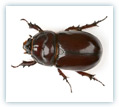-
Beetle Removal Information
Beetle Control
To get your free beetle control quote click here.
Beetles are the most common species of insect known to man. There are over 350,000 known types and more are being discovered all the time. However, the sort of beetle that you are probably familiar with is the little black or dark brown beetle which has a rounded body and short antennae and is about a third of an inch long. The friendly garden ladybird is actually a member of the Beetle family but not generally considered a pest.
The most commonly found beetles in the UK include:
• Biscuit Beetles
• Carpet Beetles
• Cigarette Beetles
• Flour Beetles
• Fur Beetles
• Furniture Beetles
• Grain Beetles
• Larder Beetles
• Leather Beetles
• Spider BeetlesThe beetles that infest your home or work premises are from the Dermestes species of beetles, the most common being larder beetles. Agricultural pests include Colorado potato beetles and the redflour beetle.
The larder beetle likes to feed on meats, cheese, skins, dried fish and dry pet foods so they can become a pest if they gain access to your food supplies. However, the main pests are the larva borne from the beetles; they can cause a lot of damage by drilling their way through wood, insulation, concrete and even lead. Full grown larvae is actually slightly longer than an adult beetle and is dark brown in colour and densely covered in stiff, bristly hairs. Beetles mate in early spring or summer and the female then lays approximately thirty eggs – in batches of two or three – in cracks or joints in timber. These take between 2 and 12 days to hatch depending on temperature and humidity.

Newborn larvae begin to feed straight away. For larvae to then turn into beetles they have to pupate, they do this by boring into something solid and staying there for between eight and fifteen days to cast their larval skin. Once they emerge again as adult beetles they live for approximately one year. Larvae are commonly referred to as Woodworm because they tunnel through the wood of floor boards, furniture, staircases or beams. The wood-boring larvae have been known to stay in their larval state for as long as five years before pupating.
Larvae and adult beetles are both quite capable of travelling long distances which mean it can be difficult to identify and rid your home of a complete infestation because you cannot locate them all at once. Firstly you should locate their food source. This means giving your living space a thorough clean and inspection including your kitchen cupboards, work-surfaces, shelves and below ovens and washing machines or in the gaps between your white goods.
The death watch beetle is another wood boring pest, which is present in many old wooden buildings in the UK. It attacks hardwoods such as oak and chestnut, always where some fungal decay has taken or is taking place. It is approximately 8mm in length and is recognised by the yellowish patches on its brown body. The death watch beetle makes a clicking sound which can be heard in attics and through walls at night. It is believed that these beetles get into the wood during construction rather than at a later date. If you suspect you may have the death watch beetle in your home then your only real chance at eradication is calling in the professionals.
Plaster beetles feed on mould and tend to live in damp conditions, they have been known to contaminate food purely because they scuttle around in unhygienic conditions but they do not actually damage property.
Gardens can be ruined by various beetle species as the chew up roots and eat the leaves, flowers and pollen of plants while their larvae damage the roots and tubers.
Loft spaces and basements or attics should regularly be checked for any dead insects, rodents or birds, which beetles may have been preying on as an additional source of food.
In food preparation areas in eating establishments such as restaurants or hotels it is important that food processing equipment is closely inspected along with any cracks, nooks or crevices in walls and worktops where debris may have accumulated as a potential food source for beetles.
Thorough cleaning and high levels of hygiene is vital in keeping beetles at bay. Residual insecticides can be applied as dusts or sprays. Carefully storing all your foodstuffs in tightly closing containers also helps to deter their presence.
You should ensure all rubbish is disposed of regularly and bin bags securely closed. If you have cracks in your windowpanes or doors these should be sealed up too. To give you peace of mind and clear your home or garden premises of a beetle infestation your best point of call is the pest control professionals who know how to identify them and exactly how to deal with them efficiently.
-
Call Me Back Now

- Area Covered

 See All Locations
See All Locations